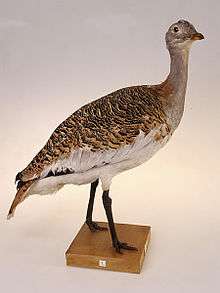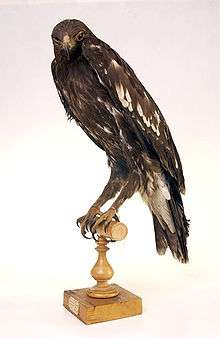Joseph Whitaker (ornithologist)
Joseph Isaac Spadafora Whitaker (Palermo, 19 March 1850 – Rome, 3 November 1936) was a Sicilan-English ornithologist, archaeologist and sportsman. He is mainly known for his work on the birds of Tunisia, and for being involved in the foundation of the Sicilian football club U.S. Città di Palermo.
Biography
Whitaker's family came from prominent Yorkshire origins.[1] The Whitaker family [2] were wealthy 19th-century tycoons from West Yorkshire, who had developed the fortified wine industry in Marsala, Sicily. During 1806, many members of the Whitaker family had moved to Sicily permanently.
Inheritance of the Vineyard Empire
He inherited vast vineyards and his great grandfather Ingham's banking empire. Choosing Palermo over the more provincial Marsala, he built the Villa Malfitano, an Italian Art Nouveau mansion near Zisa Castle on the Via Dante after his marriage to Tina Scalia. Tina was the daughter of General Alfonso Scalia who landed in Sicily with Giuseppe Garibaldi during the years leading up to the Risorgimento. They had two daughters; the elder of which married General Antonio Di Giorgio an Italian Minister of War. Thus the family was firmly established in the upper echelons of Italian Society.
In these years, the Belle Époque age, the house was the venue for lavish parties attended by British and Italian royalty. Tina Whitaker knew Richard Wagner, Benito Mussolini, the Kaiser and Edward VII, Empress Eugenie and Queen Mary. Attracted by homosexual company, she unwittingly found herself in a circle involved in the Irish Crown Jewels scandal.
Whitaker himself was founder and president of the Society for the Prevention of Cruelty to Animals at Palermo. Also he was a prime factor in the foundation of U.S. Città di Palermo in the later 1880s, a football team who he was the first president of.
Birds
In 1891 already a very keen ornithologist Whitaker joined the British Ornithologists' Union. Collecting expeditions to Tunisia followed. These extended over a period of ten years (1894–1904). Notebooks kept at the time contain information on the natural history of the birds as well as other fauna and also the flora of Tunisia.
The Tunisian bird and bird nest and egg collection was housed in a villa in the grounds of his home “Malfitano” alongside a very complete collection of Sicilian birds and collections made on his behalf by Edward Dobson in Morocco. To these were added specimens of birds from the Mediterranean littoral.
Some of Whitaker's collection of Tunisian birds are in the Natural History Museum, London. The Sicilian birds are divided between the Royal Scottish Museum (bird skins) and the Ulster Museum (bird mounts, eggs and nests).
Gallery of Birds in the Whitaker Collection
Archaeology
Whitaker devoted the last years of his life to archaeology, purchasing the island of Motya near Trapani the site of a Phoenician town founded in the eighth century BC. He wrote a book on his excavations in 1921. The site may be explored (online) using the Motya link.
Works
- Sulla migrazione degli uccelli, specialmente in Sicilia. Naturalista sicil.121-127. 1882
- Notes on some Tunisian birds. Ibis 78-100, map. 1894.
- Additional notes on Tunisian birds. Ibis 85 -106, map. 1895.
- Further notes on Tunisian birds. Ibis 87 -99, map. 1896.
- On Turnix sylvatica in Sicily Ibis 290-291. 1896.
- Exhibition of skins of Sturnix unicolor from Morocco . Bull. Brit.Orn.Club vol.vii.pxvii (p 155 of Ibis 1898). 1897
- Description of Two new species, Garrulus ornops,sp. nov., and Rhodopechys aliena, sp. nov. Bull. Brit.Orn.Club vol.vii.pxvii 1897.
- Further notes on Tunisian birds Ibis 125-132. 1898.
- On the Grey Shrikes of Tunisia Ibis 288-231.1898.
- On a collection of birds from Morocco with descriptions of Lanius algieriensis dodsoni, subsp. nov. (p. 599) and of Octocorys atlas (p.xiii) Ibis 592-610.1898.
- Description of a new Chat, Saxicola caterinae, sp. nov., from Algeria and Morocco, and a new crossbill, Loxia curvirostra poliogyna, subsp. nov., from Tunisia Ibis 624-625. 1898.
- Description of a new species of Shore-Lark, Otocorys atlas, from the Atlas Mountains of Morocco. Bull. Brit. Orn. Club. Vol.vii, p.xlvii (p 432 of Ibis) 1898.
- Sulla riproduzione in cattività del Pollo sultano (Porphyrio coeruleus Vandelli) volg. sic. gaddo fagiano o gaddu fascianu. Naturalista sic. vol.3, 17-20. 1899
- On an Abnormal nest of Ardea cinerea Bull. Brit. Orn. Club. vol. viii, p.xxxvii. 1899.
- On the breeding of the Purple Gallinule in captivity. Ibis vol. vii. p. 502-505. 1899
- On a new Chat from Southern Persia. Bull. Br. Orn. Club vol.x. p.17. 1899
- The passage of Cuculus canorus L. in Sicily. Aquila vo. vi. p.99-100. 1899
- On the Occurrence of Caprimulgus aeggptius at Palermo Ibis p. 475-476. 1899
- On a new species of Acredula from Sicily. Bull. Br. Orn. Club vol.x. 11. p.51-52. 1901
- On some species of Crested Lark. Ibis vol.xii. p.38. 1901
- On rare species from Tripoli. Ibis vol.xiii. p. 15-17. 1902
- Further information on two recently described species of Passerine Birds. Ibis. vol.x. p.54-59. 1902
- On a small collection of Birds from Tripoli. Ibis. vo.x. p.643-656. 1902
- On the occurrnce of Porphyrio alleni in Italy and Tunis. Ibisvol.xi. p.431-432. 1903
- Cisticola cisticola mauritanica subsp. nova. Bull. Br. Orn. Club vol.xiv. p.19-20. 1903
- La Glareola melanoptera in Sicilia. Avicula vo.viii. p. 84-85. 1904
- Il Corvus corone, la Linota rufescens e la Glareola melanoptera in Sicilia. Avicula vo.viii. p.56. 1904
- Corvus corone, Linota rufescens and Glareola melanoptera in Sicily. Ibis vo.xii. p.477-478. 1904
- Alauda arvensis harterti subsp. nova. Bull. Br. Orn. Club vol.xv. p.19-20. 1904
- The Birds of Tunisia, 2 Vols. Pp. xxxii, 294; xviii, 410, 17 full page plates of which 15 are handcoloured after Grönvold, 2 photograv., 1 clr folding map. London, 1st edition. Edition limited to 250 copies only. 1905 Digitised text Volume 1 Digitised text Volume 2
- Biographical notice on the late Professor Giglioli. Ibis vol.xviii. p.537-538. 1910
- Letter on Pterocles senegallus in Sicily. Ibis vo.xviii. p. 102. 1910
- Sulla necessità di legislazione internazionale per proibire l'importazione in Europa delle pelli e piume di alcune specie di uccelli. Riv. Ital. Orn. vo. iii p. 126-135. 1915
- The Birds of Sicily. Manuscript in the Villa Whitaker Malfitano. Palermo. 1920 about
- Motya - A Phoenician Colony in Sicily, London. G. Bell & Sons, 1921.[3]
References
- ↑ Whitaker Family
- ↑ CouchGenWeb - Whitaker
- ↑ Je m'appelle Byblos, Jean-Pierre Thiollet, H & D, 2005, p. 208.
- Lo Valvo, F. and Massa B. Catalogo Della Collezione Ornitologica Joseph Whitaker (1850–1936) Estrato da: Il Naturalista Siciliano.S.IV.XXIV (Suppl.), 2000 13 figures.
External links
- Works by or about Joseph Whitaker at Internet Archive
- Italian site with pictures from Birds of Tunisia
- Italian site on Whitaker
| Wikimedia Commons has media related to The birds of Tunisia; being a history of the birds found in the regency of Tunis (1905). |

























